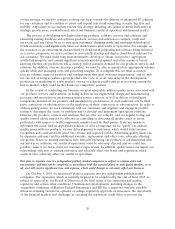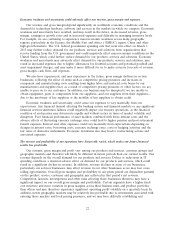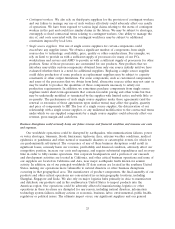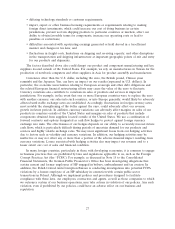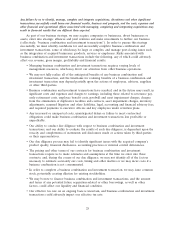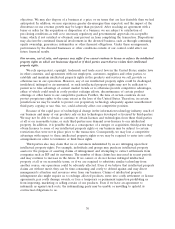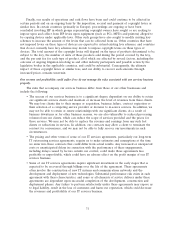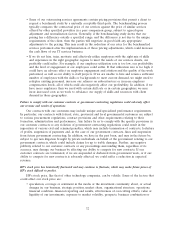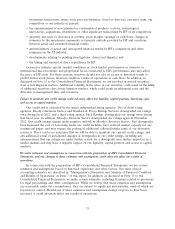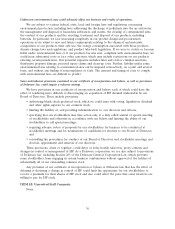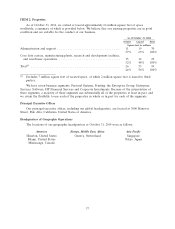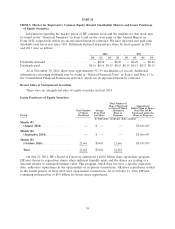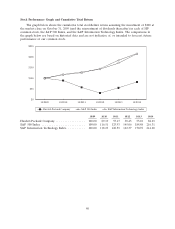HP 2014 Annual Report Download - page 38
Download and view the complete annual report
Please find page 38 of the 2014 HP annual report below. You can navigate through the pages in the report by either clicking on the pages listed below, or by using the keyword search tool below to find specific information within the annual report.objectives. We may also dispose of a business at a price or on terms that are less desirable than we had
anticipated. In addition, we may experience greater dis-synergies than expected, and the impact of the
divestiture on our revenue growth may be larger than projected. After reaching an agreement with a
buyer or seller for the acquisition or disposition of a business, we are subject to satisfaction of
pre-closing conditions as well as to necessary regulatory and governmental approvals on acceptable
terms, which, if not satisfied or obtained, may prevent us from completing the transaction. Dispositions
may also involve continued financial involvement in the divested business, such as through continuing
equity ownership, guarantees, indemnities or other financial obligations. Under these arrangements,
performance by the divested businesses or other conditions outside of our control could affect our
future financial results.
Our revenue, cost of sales, and expenses may suffer if we cannot continue to license or enforce the intellectual
property rights on which our businesses depend or if third parties assert that we violate their intellectual
property rights.
We rely upon patent, copyright, trademark and trade secret laws in the United States, similar laws
in other countries, and agreements with our employees, customers, suppliers and other parties, to
establish and maintain intellectual property rights in the products and services we sell, provide or
otherwise use in our operations. However, any of our intellectual property rights could be challenged,
invalidated, infringed or circumvented, or such intellectual property rights may not be sufficient to
permit us to take advantage of current market trends or to otherwise provide competitive advantages,
either of which could result in costly product redesign efforts, discontinuance of certain product
offerings or other harm to our competitive position. Further, the laws of certain countries do not
protect proprietary rights to the same extent as the laws of the United States. Therefore, in certain
jurisdictions we may be unable to protect our proprietary technology adequately against unauthorized
third-party copying or use; this, too, could adversely affect our competitive position.
Because of the rapid pace of technological change in the information technology industry, much of
our business and many of our products rely on key technologies developed or licensed by third-parties.
We may not be able to obtain or continue to obtain licenses and technologies from these third-parties
at all or on reasonable terms, or such third-parties may demand cross-licenses to our intellectual
property. In addition, it is possible that as a consequence of a merger or acquisition, third-parties may
obtain licenses to some of our intellectual property rights or our business may be subject to certain
restrictions that were not in place prior to the transaction. Consequently, we may lose a competitive
advantage with respect to these intellectual property rights or we may be required to enter into costly
arrangements in order to terminate or limit these rights.
Third-parties also may claim that we or customers indemnified by us are infringing upon their
intellectual property rights. For example, individuals and groups may purchase intellectual property
assets for the purpose of asserting claims of infringement and attempting to extract settlements from
companies such as HP and its customers. The number of these claims has increased in recent periods
and may continue to increase in the future. If we cannot or do not license infringed intellectual
property at all or on reasonable terms, or if we are required to substitute similar technology from
another source, our operations could be adversely affected. Even if we believe that intellectual property
claims are without merit, they can be time-consuming and costly to defend against and may divert
management’s attention and resources away from our business. Claims of intellectual property
infringement also might require us to redesign affected products, enter into costly settlement or license
agreements, pay costly damage awards, or face a temporary or permanent injunction prohibiting us
from importing, marketing or selling certain of our products. Even if we have an agreement to
indemnify us against such costs, the indemnifying party may be unable or unwilling to uphold its
contractual obligations to us.
30


